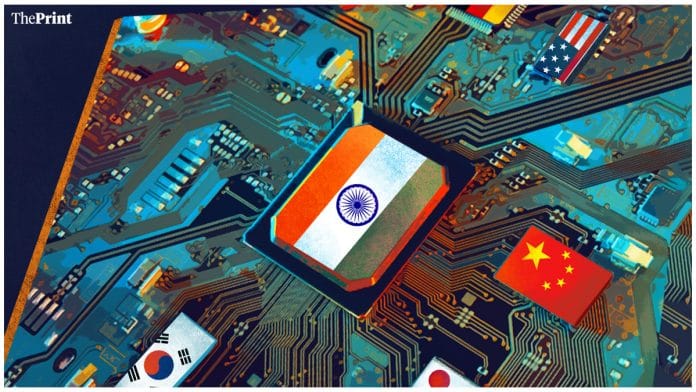On 28 July, Prime Minister Narendra Modi inaugurated the second annual SemiconIndia 2023 conference as part of the India Semiconductor Mission. Prior to the event, Micron Technology announced plans to set up operations in India. It is the largest investment by a single company so far, of over $850 million towards an assembly-and-test facility in Gujarat. The announcement came after the Modi government reopened the window for applicants under its $10 billion Semicon India Programme in June.
The semiconductor industry is geopolitically sensitive because it is central to all critical components of most digital consumer products and plays an important role to ensure a secure cyberspace. The United States of America currently dominates the sector while China is catching up fast. On 9 August, US President Joe Biden issued an executive order to block and regulate high-tech US-based investments such as computer chips going towards China, in a bid to secure American primacy. India is well placed to leverage its international standing and strengths such as its market size and vast talent pool, to compete with China, provided we play our cards right.
Global semiconductor market dynamics
The semiconductor ecosystem including its supply chain is complex, production of a single chip requires over 1,000 steps spread across multiple countries. American businesses account for over 48 per cent of the market share in semiconductors, predominantly through their vast expertise in upstream research and innovation. Europe also specialises in research and design-intensive segments and is a supplier of critical semiconductor manufacturing equipment. Leading semiconductor incumbents in the Asia-Pacific region, such as South Korea, Japan and Taiwan occupy another 36 per cent of the market share with their expertise in downstream capital and labour-intensive manufacturing segments.
Conversely, China is the single-largest semiconductor consumer and contributes to over a third of global revenues. To meet this demand, the country has developed capacity — particularly in the downstream assembly, testing and packaging (ATP) segment — and has captured a seven per cent market share in the last two decades. This specialisation also enables Beijing to meet the semiconductor demand for its massive electronics industry. It is now attempting to dominate the fabrication market (i.e., the manufacturing segment). There is wide consensus among other nations dominant in the semiconductor supply chain that dependence on Chinese suppliers poses unacceptable levels of security and economic risks.
Also read: German car industry to take years to overcome chip shortage, says Audi senior manager
Trusted semiconductor partner
While the semiconductor supply chain is fragmented, specialised process segments are concentrated in a handful of countries. No single country is an expert across the value chain and industry specialisations are spread across the US, its allies ( Japan, South Korea and the EU) and China. Consequently, India can target and develop technical capacity in specialised segments to recalibrate the supply chain as a trusted partner.
Chinese firms currently dominate the assembly, testing and packaging (ATP) segment. India offers fiscal support to the tune of 50 per cent of capital expenditure for ATP plants. It also allowed proposals to set up fabrication plants for manufacturing mature semiconductor nodes above 40 nm, a segment in which China has mass production capacities. In addition, state governments have also proposed to support over 20 per cent of project utilities cost (power, land and water) for local manufacturing.
These developments coupled with the Indian government’s ambition to train over 1,00,000 skilled chip design engineers by 2028, signals growth potential. However, while the cumulative developments are important, they are not enough to give India an edge over China just yet. For instance, while India’s consumer electronics manufacturing base — a key driver of the demand for chips — is rapidly growing, it is currently valued at less than a fifteenth of its Chinese counterpart.
Also read: How Biden has used an executive order to restrict US firms’ investment in China’s high-tech sectors
What will set India apart?
Three steps can help India achieve its semiconductor manufacturing goals. First, developing technology partnerships with countries that specialise in semiconductors and their components is critical. The India-US initiative on Critical and Emerging Technology (iCET) and the semiconductor development MoU with Japan are steps in the right direction. India must also explore deeper partnerships with countries such as the Netherlands, a dominant semiconductor manufacturing equipment supplier, particularly for lithography systems.
Second, India must overcome its reticence to discuss trade issues at the Indo-Pacific Economic Framework for Prosperity (IPEF), a US-led initiative that brings together 14 Asia-Pacific economies on issues such as supply chains, trade and decarbonisation. India is the only nation that opted out of IPEF discussions pertaining to trade issues in 2022. This is counterproductive to the aim of integrating with complex semiconductor supply chains.
Finally, a robust intellectual property (IP) framework is a prerequisite to success. Chinese firms are under scrutiny due to allegations of IP theft. Therefore, a well-defined IP system can help India attract international investors and safeguard technology transfers. While the country introduced the Semiconductor Integrated Circuit Layout Design (SICLD) Act in 2000, to protect IP rights within semiconductor design segments, it should also revisit and upgrade current IP laws, and consider passing legislation to protect trade secrets, in order to build investor trust.
India stands at a pivotal juncture in the global semiconductor story. Regrettably, two of the three earlier proposed mega projects — the Vedanta-Foxconn joint venture and the ISMC — are stalled. Given the current turn of events, India must pursue a multi-dimensional approach as outlined here. This will also help operationalise the notion of ‘trust’ in critical supply chains.
The authors work at Koan Advisory Group, a technology policy consulting firm. Views are personal.
This article is part of ThePrint-Koan Advisory series that analyses emerging policies, laws and regulations in India’s technology sector. Read all the articles here.
(Edited by Theres Sudeep)






